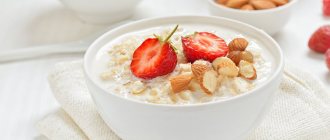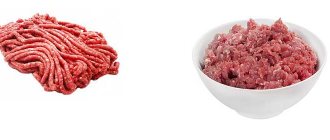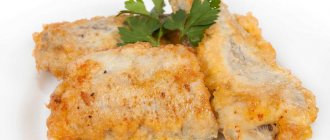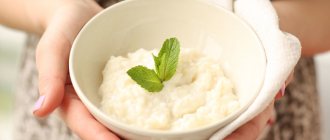Buckwheat porridge is a nutritious and low-calorie product that saturates the body with vitamins (B1, B2, B6, etc.) and useful minerals, including calcium, iron, potassium, magnesium, etc. When consumed regularly, buckwheat reduces cholesterol levels in the blood, cleanses the liver of toxins and normalizes intestinal function. Cereals without salt and oil are used for weight loss. The calorie content of porridge depends on the presence of various ingredients in the product (sugar, salt, etc.). Therefore, before preparing a dietary dish, calories are counted first.
Chemical composition
The composition of buckwheat is represented by a huge amount of vitamins and other very useful substances that help improve the functioning of almost all systems in the body. This doesn't only apply to adults. Dishes from the river will also be useful during gestation, and directly for children starting from 5-6 months from birth.
| Main components | Minerals |
|
|
The table below shows exactly what beneficial substances are contained in plain buckwheat. Based on this, it becomes clear why it is considered such a useful product.
Peculiarities
Boiled buckwheat porridge with water has a minimal amount of calories and does not contain even small amounts of gluten. Therefore, it is great for anyone who suffers from contact with gluten. It is quite acceptable to use this dish for early complementary feeding of children. Buckwheat porridge contains many vitamins and minerals, valuable amino acids.
It is recommended to use:
- those suffering from anemia;
- pregnant women;
- people with a distorted balance of water and salt;
- those who want to organize proper nutrition.
The chemical composition of buckwheat is well balanced. This product can be safely recommended to those who have high blood sugar concentrations - it will soon decrease. With regular consumption of buckwheat, there is a decrease in joint pain and an improvement in skin diseases. Hair, teeth, nails look better. It remains to be seen how exactly buckwheat with butter can change the overall nutritional value of the diet.
Calorie content of buckwheat boiled with butter
It should be said that the calorie content of buckwheat directly depends on the variety, but in addition, it should be noted that the number of calories can also vary due to additional components. For example, if you cook buckwheat:
- on water it turns out 90 kcal;
- when adding salt, the calorie content can increase by another 15 units;
- adding vegetable oil, kilocalories increase to 150 kcal;
- If you prepare boiled buckwheat with butter, then the calorie content per 100 grams will be 170 kcal.
It also needs to be said that when cooking buckwheat in milk, kilocalories can vary from 118 to 160 kcal. These values depend on the fat content of the milk used. For those who want to lose extra pounds, but still love milk, it is recommended to use a low-fat product. That is, buckwheat with butter has the highest calorie content. This applies to both vegetable oil and butter.
Is it possible to lose weight on salted buckwheat?
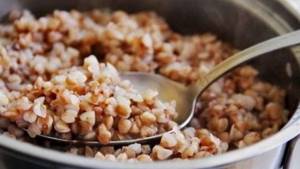
Nutritionists do not recommend salted buckwheat for those losing weight, and here’s why:
- A salty product increases appetite, since spices actively affect the taste buds.
- Porridge with salt retains fluid in the body, which leads to edema.
Advice! If you don’t want to eat the product without salt, the spice is added to the dish, but in a minimal amount. Losing weight with this approach will not be easy, but it is possible (if you eat in small portions and lead an active lifestyle).
Unleavened porridge, on the contrary, satisfies the feeling of hunger faster, which allows you to eat much less at one time.
Properties of boiled buckwheat with butter
Everyone knows that buckwheat is considered very healthy, but it should be noted why it is useful and whether the indicated grain has contraindications must definitely be indicated.
Benefit
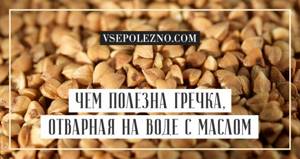
Buckwheat porridge is not only tasty, but also healthy. It is recommended to eat it directly not only because it contains a very large amount of useful microelements. Buckwheat should also be used as a preventive measure for diseases such as:
- Atherosclerosis – in this case, the process of removing cholesterol from the body occurs.
- Diabetes mellitus type 1 and 2. Allows you to reduce blood sugar levels.
- Gastritis. Recommended for use as part of a therapeutic diet.
- Osteoporosis. Provides the opportunity to strengthen bone tissue with the necessary microelements, for example, calcium, magnesium and zinc.
- Pancreatitis. It should be used as a therapeutic diet immediately 5-6 days after the onset of an exacerbation of the disease. Buckwheat is cooked exclusively without sugar, salt and oil in water with the addition of milk in a 1:1 ratio.
Buckwheat can also be consumed by people who suffer from rheumatic diseases, inflammation of the joints and those who have pathologies of the cardiovascular system or intestinal disorders. In addition, the buckwheat diet, used for weight loss, has proven itself well.
It is important to know! The greatest benefit of buckwheat is found in light-colored grains. If the grain is darker in color, this indicates that the grains were subject to significant heat treatment, and accordingly there are fewer useful substances left in it.
Despite the usefulness of the designated product, there are also contraindications. For example, there are people who have individual intolerance. This is due to the fact that cereal contains a fairly large amount of protein. It is also not recommended to consume buckwheat for people suffering from:
- low blood pressure;
- diabetes mellitus;
- diseases affecting the gastrointestinal tract.
It should also be said that quite a lot of people use sprouted buckwheat as food, but this type of product is contraindicated for those who have high blood clotting. In addition, it is necessary to indicate that overeating is also fraught with side effects. They may be:
- disruption of the digestive process;
- allergic reactions may occur;
- there is a possibility of diarrhea or constipation;
- Severe headache may occur.
Quite often, people who consume buckwheat in large quantities suffer from severe fatigue and feel very overworked. Once again, we need to remind you that if a person has a disease such as diabetes, then you need to eat buckwheat dishes with extreme caution.
It is important to know! Buckwheat is a product that is capable of absorbing not only all odors, but also toxic substances from the environment. Therefore, it is necessary to store buckwheat directly in tightly closed containers.
How many calories are in 100 grams of dry buckwheat?
The beneficial effect of buckwheat on the body is explained by its balanced composition and the content of a large number of nutrients. With its regular use, blood sugar decreases, painful manifestations of joint and skin pathologies decrease, and the condition of teeth, hair, and nails improves.
The high nutritional value of the product is explained by the content of complex carbohydrates, thanks to which a person does not feel hungry for a long time. In addition, the composition contains easily digestible proteins.
The calorie content of raw buckwheat per 100 g (this amount is enough to prepare 2 servings) is 306 kcal, which is less than any type of rice (340 kcal), millet (334 kcal) and corn grits (325 kcal). You can read more about the calorie content of cereals here.
Indicators of the energy value of different types of buckwheat:
- 290 kcal – food grain;
- 306 kcal – done;
- 308 kcal – green cereals;
- 313 kcal – core.
Green buckwheat is a special variety recommended for consumption by nutritionists. The cereal is obtained by separating the fruit from buckwheat grains.
How to cook buckwheat with butter
In cooking, there are many different recipes for preparing buckwheat. But you should know how to prepare it correctly in order to preserve the maximum amount of nutrients in it.
Initially, it should be noted that to obtain crumbly buckwheat porridge, you need to pour boiling water over it before starting cooking. If you pour cold water over the cereal, you will get a more viscous consistency of the finished dish. Cooking time should be approximately 15-20 minutes. But it is worth considering that you need to cook buckwheat directly over low heat.
It is also necessary to indicate that it is necessary to take into account that the ratio of water and buckwheat should be 2:1. That is, 2 glasses of water for 1 glass of buckwheat. To add flavor to the finished buckwheat, you can add the following products:
- salt, pepper to taste;
- onions fried in vegetable oil;
- meat;
- mushrooms and even hard cheese.
You can also cook dishes from boiled buckwheat with butter simply in water, but do not forget that in this case its calorie content increases significantly.
With milk
The basis for preparing buckwheat porridge directly is completely similar to the previous described recipe. As for adding milk, it can be poured into the plate after, that is, into the finished porridge.
I would like to note that if you use homemade milk, it is recommended to boil it first. If you use store-bought milk that has been pasteurized, then boiling it is not required.
Steamed
The simplest option for preparing buckwheat porridge directly is to steam it. To do this, you need to rinse the cereal well and place it in a saucepan or in a special cast-iron cauldron and pour boiling water over it.
Then you should wrap the kitchen utensils with steamed buckwheat in a thick towel or other similar material and leave it to steam. It is best to cook buckwheat overnight. This way the cereal will steam well, and in the morning the resulting porridge can be heated directly in the oil.
How and how much you can use
Considering that buckwheat is a very healthy product, it cannot be used as a permanent product. In addition, depending on the age category, cooked porridge per day is limited to a certain amount of grams.
Pregnant
Pregnant women, as well as those breastfeeding their babies, are recommended to eat buckwheat porridge directly, unless, of course, they are allergic to this product. This is due to the fact that the indicated cereal contains not only many useful micro and macroelements, but also quite a lot of protein.
In addition, buckwheat should be present in the diet of every pregnant woman, since it helps increase hemoglobin in the blood, thereby increasing the supply of oxygen for the normal development of the unborn child. But this does not mean that the designated product should be the main one in the diet.
As for the quantity, it can be consumed taking into account personal preference, that is, as much as the stomach allows, but at the same time it should be present in the diet no more than 1-2 times a week. Although, if the body requires more of the designated cereal, then you can eat it every day, but in small portions.
It is important to know! Eating buckwheat porridge during pregnancy allows a woman to eliminate the risk of anemia. In addition, thanks to the designated product, the occurrence of hypoxia of the developing fetus in the womb can be avoided.
Regarding the question of using buckwheat for children, it can be introduced into complementary foods for children who are already 4-6 months old. But it should be noted that initially you need to consult directly with a pediatrician.
According to experts, as a first complementary food, small children can be given initially no more than 0.5-1 teaspoon, for example, before meals. If this is a baby, then buckwheat puree mixture can be given before breastfeeding.
It should also be noted that in the absence of any negative manifestations after eating buckwheat for children, you can increase the serving size every day. That is, over the course of 7-10 days it is possible to increase the portion of buckwheat porridge to the age norm, namely up to 120-15 grams per day.
With stew
| Name | Quantity | fats | carbohydrates | squirrels | Total kcal |
| Buckwheat (2.5 cups) | 500 gr | 13 | 340 | 63 | 1729 |
| Stew (1 can) | 400 gr | 69.6 | 0 | 56.4 | 852 |
| Water (5 glasses) | 1.2 l | 0 | 0 | 0 | 0 |
| Onion (2 pcs) | 200 gr | 0 | 20.8 | 2.8 | 96 |
| Carrots (1 piece) | 100 gr | 0.1 | 6.9 | 1.3 | 35 |
| Volume. pasta (3 tablespoons) | 100 gr | 1.5 | 16.7 | 5.6 | 104 |
| Butter (3 tablespoons) | 100 gr | 82.5 | 0.8 | 0.5 | 744 |
| Total calories in 9 servings/250 grams | 2350 gr | 1500 | 1540 | 519 | 3560 |
100 grams of buckwheat with stew contains 151 kcal.
Stewed dishes are universal, easy to prepare and valued for their high taste.
